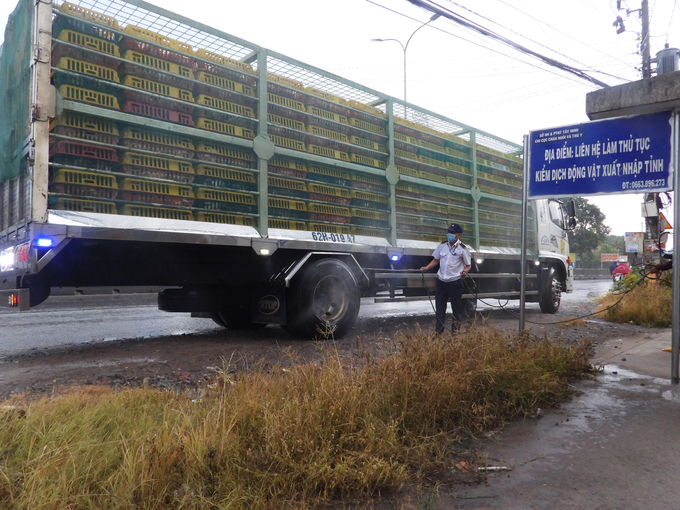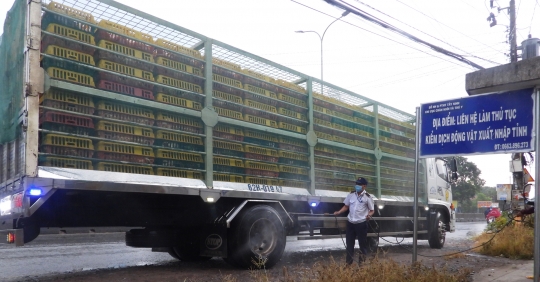
Quarantine Station Suoi Sau. Picture: Tran Trung.
Dinner was being served more than 19 hours a day at the Suoi Sau quarantine station near Ho Chi Minh City in late June, but no one was seated at the table yet. Station members each performed a task: someone gave the order to stop the vehicle, someone sprayed disinfectant, someone climbed onto the trunk of the vehicle to conduct a clinical examination and ensure there were no infected animals before traffic could continue from Tay Ninh province.
Talk to PV Bao NNVNNguyen Thanh Hai, quarantine officer at Suoi Sau Station of Tay Ninh Animal Husbandry and Veterinary Division, said that as a border province with many border gates and open routes, Tay Ninh is very convenient for trade and exchange, etc., so Tay Ninh always has a potential risk of disease outbreaks in livestock and poultry across borders and open roads.

Seal Control Station officials. Picture: Tran Trung.
In addition, since Suoi Sau Railway Station is adjacent to Ho Chi Minh City, the largest bustling market in the country, the responsibility of the railway station is very great. On average, tens of thousands of vehicles are on the move every day, transporting thousands of livestock and poultry through the station. Therefore, the staff here always strives to carefully carry out the quarantine when transporting animals and animal products in order to prevent the development and spread of diseases.
This is also an important task to ensure food safety and hygiene for consumers, not only in Tay Ninh Province but also for nearly 10 million people in Ho Chi Minh City. Therefore, the station staff always focus on expertise, do not neglect subjectivity, continuously strengthen 24-hour inspection and supervision, and ensure the assigned responsibility.
According to the inspection process, after the vehicle enters the station, the officer will check the quarantine certificate and other related documents, check whether the quantity, species and animal products are in accordance with the quarantine certificate, check the veterinary hygiene conditions for the transport vehicle, check the animal’s health status, stamp the inspection, issue a receipt for collecting the fee, and then arrive and disinfect the vehicle before leaving the Tay Ninh area.
“The whole station has 3 officers, divided into two shifts, rotating day and night, although there are still many difficulties, because the armed forces are thin, the equipment for work is lacking, the coordination between the local district functional forces and the station is sometimes out of time and synchronous, especially the veterinary unit does not have the right to stop the vehicle, but the station always shares its efforts to cope, and works closely with local functional forces to complete the task.”

The quarantine officer checks the exit papers. Picture: Tran Trung.
Mr. Nguyen Thanh Hai added that in addition to controlling animal movements, the unit also actively cooperated with local authorities and veterinary authorities to inform and guide farmers in proactively implementing biosecurity measures, particularly in implementing 5 Nos.
This does not mean covering up epidemics, not trading or transporting sick or dead animals, not slaughtering and consuming sick or dead meat, not disposing of dead animals in the environment, and not using food with residues of prohibited substances. At the same time, the epidemic situation in livestock farms and slaughterhouses must be carefully examined and monitored in order to identify and combat epidemics in good time.
According to the Department of Livestock and Veterinary Medicine of Tay Ninh Province, the livestock and poultry epidemic situation was generally stable in the first six months of the year, with no emergence of dangerous infectious diseases. The management of livestock and slaughterhouses must comply with the regulations. Faced with the threat of epidemics, the sub-department clearly assigns quarantine officials areas to be quarantined from the farm to the slaughterhouse.
“The sub-department has strengthened quarantine management and control over the transport of animals and animal products. Actively coordinate with market management authorities and relevant authorities to investigate, monitor, detect and strictly deal with cases of trade, transportation, slaughter and processing of animal products that do not meet the requirements of effective disease prevention and control and food safety for people,” Ms. said

